This was published 1 year ago
‘I’d never seen a courtroom so still’: The witness who rocked the Roberts-Smith trial
For six anxious months in the “defamation case of the century” launched by SAS veteran Ben Roberts-Smith, it was unknown whether a key witness would testify against him. In his forthcoming book Crossing the Line, an investigative journalist at the heart of the trial shares the moment that changed its course.
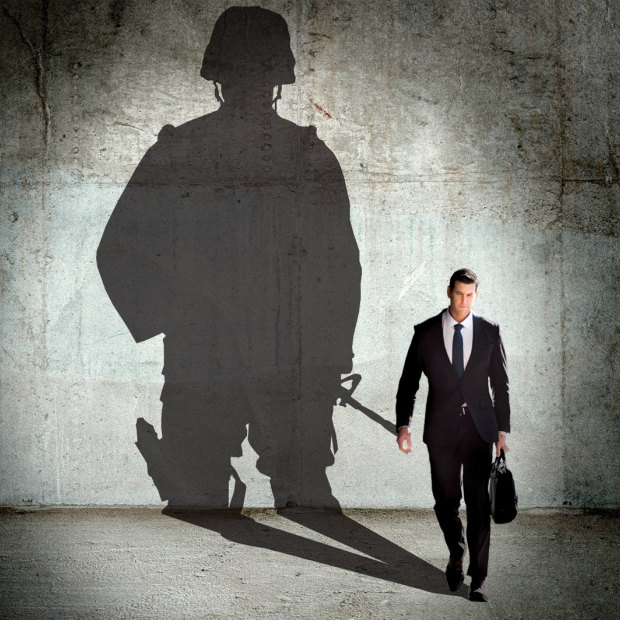
A former colleague of Ben Roberts-Smith described him as polarising - loved and hated, a walking embodiment of entitlement and arrogance. Credit: Illustration: Ollie Towning Photo: Oscar Colman
Federal Court, June 2021
I felt a hand grip my shoulder and a voice whisper into my ear as I sat in the Federal Court.
“Nick. Come with me now. Something bad has happened.”
The whisperer was Dean Levitan, a 30-year-old media lawyer who, through a combination of timing and circumstance, had come to lead the small legal team representing me and journalist Chris Masters in what the press had dubbed the defamation trial of the century. War hero and Victoria Cross recipient Ben Roberts-Smith v the two of us and our employer newspapers, The Age and The Sydney Morning Herald.
I turned my head and Levitan indicated that I should follow him out of the courtroom. His face looked pale and as I noticed this, a surge of panic felt like it was twisting up my stomach.
At that very moment, Roberts-Smith was in the witness box, his deep and authoritative voice rebuffing question after question from our counsel, Nicholas Owens SC. Even I had to acknowledge his manner was both impressive and believable.
Each morning, walking into court past a throng of journalists, Roberts-Smith had radiated confidence, his suit impeccably pressed, his chin held high. Whenever I caught Roberts-Smith’s eye, he would coolly hold my gaze. If I cocked my eyebrow, he would do the same. This had made me wonder if he was enjoying the contest unfolding in courtroom 18D and if it would destroy his reputation – or mine. As I rose to follow Levitan out of the court, every fibre in my body was telling me that it would be the latter. If Levitan was saying something bad had happened, it meant we were in deep trouble.
When I’d first met Levitan in 2018, after we were first sued by Roberts-Smith, I’d pushed back at the suggestion from his legal firm, MinterEllison, that a 27-year-old lawyer with a boyish face should play a key role in a case that was not only threatening to swallow up my career but also my mental health. “He’s very, very good,” Levitan’s boss had told me. “Give him a chance.”
Three years on, I was glad I had. He was ferociously intelligent and intensely serious. Even more, Levitan had given up his life for the Roberts-Smith case, becoming as invested in it as Masters and I were. He also had a rare ability to stay calm when things went wrong. Unlike me.
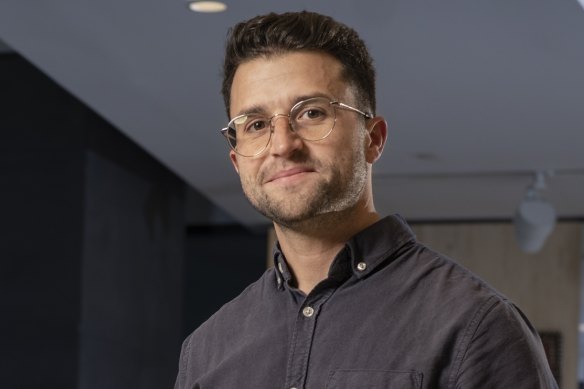
The journalists’ solicitor Dean Levitan, described by the author as “ferociously intelligent”.Credit: Eamon Gallagher
My decision in 2017 to investigate Roberts-Smith and rumoured allegations of war crimes had sent my anxiety into overdrive. When I had told my former editor that Masters and I were coming close to corroborating allegations of battlefield misconduct that we believed the public deserved to know about, he’d responded: “Do you really want to shoot Bambi?”
The decision to carefully publish stories throughout 2018 that, at first, didn’t even name Roberts-Smith had led to Masters and me being pilloried by politicians and radio shock jocks.
Brendan Nelson, the then Australian War Memorial director and ex-defence minister, went fiercely into bat for Roberts-Smith, as did billionaire businessman Kerry Stokes, the chairman of Seven West Media, where Roberts-Smith had landed a plum executive role after leaving the SAS in 2013.
Masters and I had both received threats of violence from veterans who didn’t know Roberts-Smith but believed our reporting amounted to a treasonous attack on the Anzac legend itself. We had countered publicly that the concern about alleged war crimes wasn’t a product of our imaginations, but of hundreds of conversations with Defence Force insiders, including men who had served on the ground with the SAS in Afghanistan. A public relations company geared to protect Roberts-Smith had easily drowned out this response, briefing reporters from conservative outlets all too willing to attack us.
My anxiety had reached fever-pitch by the start of the trial in mid-2021 and the realisation that, despite our best efforts and a defence that, on paper, was compelling, key SAS witnesses were refusing to cooperate.
This wasn’t all. Our brilliant senior counsel, Sandy Dawson, had been diagnosed with brain cancer on the eve of the trial, prompting a scramble to find a replacement in Owens, a barrister who, while equally brilliant, had never run a defamation case.
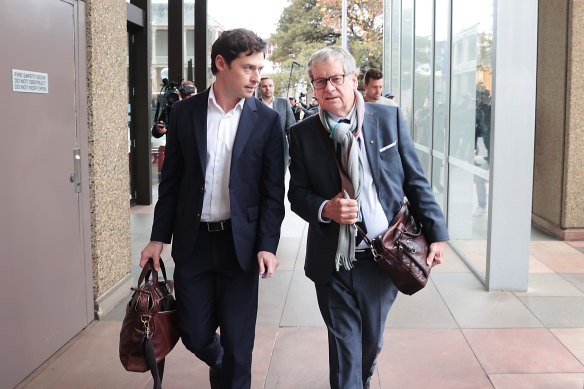
Nick McKenzie (left) and Chris Masters, the journalists at the heart of the case. Both had received threats of violence from veterans who saw their reporting as a treasonous attack on the Anzac legend.Credit: AAP
I had reacted to this growing list of problems with despondency and countless exasperated calls to Levitan. He would respond with a calm assurance belying his age. I’d come to appreciate Levitan in a more profound way. This junior lawyer, 10 years younger than me, had become a calming influence in a never-ending storm. But, at this moment, Levitan didn’t look calm; he looked as panicked as I felt.
The news was grim. Our key witness, the man upon whom the fate of a large part of the trial would likely rise or fall, would not be coming to testify. Without this witness, a veteran named Jason Andrews*, we would have no chance of proving the war crime allegation at the centre of the case.
We had revealed this allegation in an article that detailed how Roberts-Smith had kicked a handcuffed civilian off a cliff in the southern Afghan village of Darwan on September 11, 2012, and then overseen his execution. The risk now looming in court was that Australians would, in time, be left with a singular, inescapable conclusion: Roberts-Smith had been stitched up by the media, a war hero unjustly tarnished.
Andrews was one of several of our SAS witnesses who we were worried would resist taking to the witness box. This was understandable. They had bravely served their country in the best tradition of the Australian military, only to witness Roberts-Smith engage in atrocities.
I couldn’t let him know I thought he was right, and that maybe the decision I’d made four years earlier to start investigating him was one I should never have made.
But while they might have been willing, or in some cases compelled, to disclose this to authorities, the traumatic prospect of taking to the stand to testify against a brother soldier was hardly enticing. Roberts-Smith’s decision to sue Masters and me was our fight, not theirs.
Roberts-Smith was also waging a covert war to silence those soldiers he feared knew the truth. He had sent them anonymous threats and briefed journalists against them. Now, it seemed like his campaign was working.
“We’re f---ed,” I told Levitan. “We are totally f---ed.”
The young lawyer didn’t reply and I followed him out of the room and back into the court, making sure I didn’t catch the eyes of Roberts-Smith’s parents or legal team. If they were watching me, they would surely see that something was terribly wrong. I sat back in my seat as everything in the courtroom – the lawyers, the barristers, the government officials – turned into a blur, a sea of eyes that needed avoiding.
Was I having a panic attack? I could feel sweat running down my back. I tried to write in my notebook, but couldn’t think of any words to put down. All I could hear was Roberts-Smith’s voice, calmly dismissing each question from our counsel.
I forced myself to look at him, but immediately looked down before his gaze could meet mine. Roberts-Smith sounded like a man sure he was winning. I couldn’t let him know I thought he was right, and that maybe the decision I’d made four years earlier to start investigating him was one I should never have made.
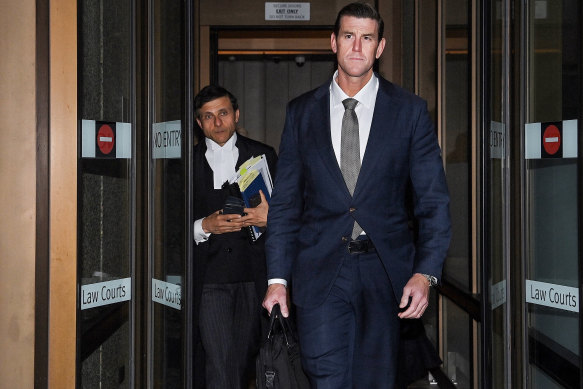
Ben Roberts-Smith leaving the Federal Court in Sydney with barrister Arthur Moses SC in June 2021.Credit: Kate Geraghty
October 2017
I slipped my shoes on and crept out of the house. It was still cold and dark, but I couldn’t sleep. As I ran past Californian bungalows and 1950s red-brick houses towards a local creek, I was reviving an old tradition.
Whenever a story I’d written that had already sparked legal threats and an editor’s intervention was about to hit newsstands and porches in Melbourne and Sydney, I’d lie in bed, legs sweaty and restless, mind racing with the question: What have I got wrong?
As if searching for a slip-up, I’d log on to the newspaper’s online system at 2am and re-read my copy, cursing grammatical errors as I searched for anything seismically flawed. My copy would have already passed through three or more editors, but I’d log in again at 3am and check. Just in case I’d stuffed up. When I still couldn’t doze off, I’d put on my sneakers and a hoodie and run into the dark morning, a ghostlike figure pounding his worry out of existence.
That morning, I headed out at 5am. My story about Roberts-Smith was short, fewer than 1000 words, carefully penned and even more carefully legalled.
I had written about Roberts-Smith’s first seminal battle and first major decoration, a Medal for Gallantry for what the official record described as “courage, tenacity and sense of duty to his patrol”. My story also detailed how Roberts-Smith’s medal citation had not dealt with all the events of that historic day.
The article described how Chris Masters had, while researching his book on the Afghan war, uncovered conflicting accounts from Roberts-Smith’s own patrol team about the death of an Afghan teen.
According to Roberts-Smith, jealousy was the reason for his colleagues’ misgivings over the teen’s death, the subsequent battle and his supposed bullying of a fellow soldier. He believed his comrades were bitter that he had won not just a Medal for Gallantry but also a Victoria Cross for an heroic action in 2010.
“The bullying is what they do to me,” he had told Masters in a tense interview months earlier for No Front Line, the journalist’s book that was due to be released in late 2017.
My copy would have already passed through three or more editors, but I’d log in again at 3am and check. Just in case I’d stuffed up.
As I ran, the pre-dawn light illuminated my path. Warehouses to my left, the swollen creek to my right. I wondered why Roberts-Smith had reacted so defensively to my efforts to engage with him. Weeks earlier, I’d sent him a LinkedIn message requesting a meeting or interview. My message was polite and respectful, but had also flagged the fact of the ongoing Brereton inquiry into rumours of unlawful conduct in Afghanistan. I’d also written that it was “clear” that Roberts-Smith was “a target for some complainants”.
With Masters’ help, I had made contact with several Defence Force insiders, obtaining a complaint about Roberts-Smith signed by a small number of SAS patrol commanders. It detailed concerns from a 2012 mission about Roberts-Smith’s bullying and attempt to cover up and blame a bungled mission on a junior trooper.
My LinkedIn message was a genuine attempt to speak to Roberts-Smith, open to the possibility he was being unfairly criticised by his old comrades. But rather than a response, I’d received a blistering email from a defamation lawyer, Mark O’Brien, known for his aggressive tactics on behalf of his clients.
Any hint in print that Roberts-Smith was under investigation for “any alleged misconduct or breach of duty in Afghanistan will be a most despicable and indefensible defamation”, O’Brien had written. On behalf of his client, O’Brien had not only threatened to sue me for defamation “without further notice”, but wrote that if Roberts-Smith learnt I had made “false allegations” while talking to people during my journalistic research, I’d also be in legal trouble.
The story that The Age and The Sydney Morning Herald had printed and was going out into the world as I ran along the creek, the sun rising, was titled, “The fog of war and politics leads to controversy over Afghan war mission”. With my editors breathing down my neck, and O’Brien breathing down theirs, I’d made no suggestion Roberts-Smith was implicated in war crimes, even though the truth seemed somewhat murkier. Masters and I had by now spent weeks hitting the phones. In whispered conversations with SAS insiders, including soldiers and support staff, the conduct of Roberts-Smith’s patrol had come up again and again.
It was evident that these opaque tales were eating away at some SAS members, fuelled by stories told in jumbled snippets at barbecues, pubs and, increasingly, during veterans’ debriefings with psychologists. None of our sources was a direct eyewitness to any execution, but many had expressed a genuine concern that Roberts-Smith, or those close to him, had crossed moral lines on the battlefield.
As I began to run back towards home, my thoughts turned to the loudest whisper about Roberts-Smith. It involved a story about an Afghan prisoner who had been pushed, thrown or kicked from a great height in a village called Darwan in the badlands of southern Afghanistan in September 2012. I was deeply sceptical about this allegation. To me, it seemed too far-fetched, too ugly, too brutal, even for soldiers who’d endured endless deployments to an endless war.
At times, Masters and I felt like two men stuck in quarantine, too contagious to meet.
But the story had stayed with me over the following months, as Masters and I tried to speak to members of Roberts-Smith’s patrol teams. Our intent was clear. We wanted to find eyewitnesses to back up the allegations we’d heard.
Responses ranged from gruff hang-ups to polite no-comments. “I know exactly what you are talking about,” one soldier had stammered. I knew he was close to Roberts-Smith and I had, seconds before, explained I was investigating allegations of war crimes. “But I can’t talk to you.”
For hours we waited in hotel rooms, bars and coffee shops for a call back, only to hear nothing. At times, Masters and I felt like two men stuck in quarantine, too contagious to meet.
But in time, calls began to be returned. A junior officer who had been deployed to Afghanistan on multiple occasions agreed to meet us at a Perth cafe overlooking the Indian Ocean. He arrived, covered in sweat, carrying two weights he’d held tightly as he’d run several kilometres to meet us.

An exhibit in the Ben Roberts-Smith defamation case, showing the village of Darwan. The “X” marked with “B” and an arrow is the cliff from which Ali Jan was kicked by Roberts-Smith.
This officer appeared on edge as he described the mental state of a small number of soldiers who appeared to relish killing. “Attack dogs” and “light switches that can’t turn off”, he called them.
Those with truly dark interiors were in the minority, outnumbered by the honourable. But these few “functioning psychopaths” had embedded themselves in the regiment, forming cliques that operated like “bikie gangs, black holes that had sucked in junior soldiers”.
When soldiers hinted at witnessing atrocities committed by their own, the officer had told them to alert the chain of command. But higher-ranking officers had taken a “don’t know, don’t care” attitude, fuelling a lack of oversight and accountability.
Masters finally mentioned the elephant in the room. Roberts-Smith had come up in “plenty of hushed conversations”, the officer responded. The VC recipient was polarising – loved and hated, a walking embodiment of entitlement and arrogance.
“Have you ever heard of a mission to a village called Darwan?” I asked him. He nodded. He had heard something bad had been “covered up”. But he knew no more.
One Afghanistan veteran spoke as his wife served us tea and biscuits. Another downed wine after wine.
Different versions of our conversation with this officer were repeated over the next two days in meetings at bars and coffee shops. One Afghanistan veteran spoke as his wife served us tea and biscuits. Another downed wine after wine.
The picture they painted was complicated. Many were proud of their own service and that of their mates, of missions conducted with bravery and honour. But as our week in Perth neared its end, the story firmed of what had taken place at Darwan in 2012. It wasn’t yet corroborated, but there was a consistency to the accounts disclosed by SAS soldiers.
At the very last compound on a ridge in the village, shortly before the SAS was due to fly back to base, Roberts-Smith’s patrol had been keeping watch over a small number of Afghan prisoners. One of the men had annoyed Roberts-Smith. He’d been taken to the edge of a small cliff above a dry creek bed and, without warning, kicked over the edge and, then, summarily executed.
After this, Roberts-Smith’s patrol had agreed to cover up the crime by claiming the prisoner was an insurgent with a radio. But the cover-up had been compromised. One patrolman in particular, we’d been told, couldn’t rid his mind of an image of the Afghan hurtling over the edge, his face meeting rock, teeth exploding from his mouth. The patrolman was Jason Andrews.
Andrews was one of those who held the key to unlocking the secrets of Darwan, but he was also one of those who hadn’t taken our repeated calls.
Melbourne, May 2018
“Ali Jan. His name is Ali Jan.”
I sat at my desk as Afghan journalist Rashid Ghulam spoke excitedly from his base in Kandahar in the south of the country.
“His wife is Bibi. His children are seven in number. He farmed the almonds, and was shepherd to the animals and picked the firewood.”
“Are you sure?” I asked. “Are you sure that’s him?”
Rashid responded fiercely, proudly. “Of course I am sure. I am a journalist just like you. The villagers told me many times. Ali Jan is the one who was kicked. Ali Jan is the one who was killed.”
When I’d asked Rashid if he could find locals from a tiny village visited by Australian forces almost six years before, the freelancer responded cautiously. The Taliban’s influence in southern Afghanistan was growing again and journalists were not welcome.
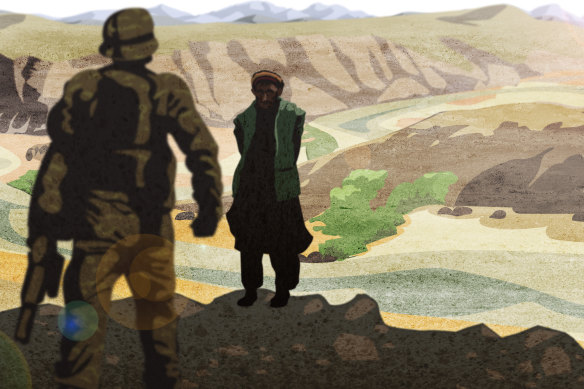
Afghan villager Ali Jan was marched to a cliff edge with his hands tied behind his back.Credit: Matt Davidson
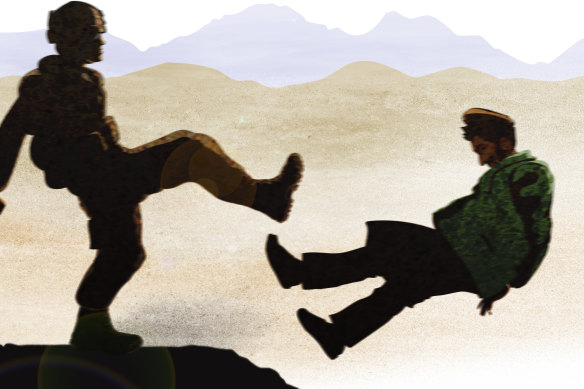
From three or four metres away, Ben Roberts-Smith walked forward and kicked the man, catapulting him backwards.Credit: Matt Davidson
By the time I called Rashid to see if he’d made any progress, Masters and I had mapped out the key details of the mission to Darwan by talking to those from the SAS who’d been on the ground that day, and other confidential sources. We confirmed the SAS had swept into the village on September 11, 2012, detaining dozens of men as soldiers searched for a rogue Afghan Army soldier who had a fortnight earlier murdered three Australian soldiers.
If the day’s manhunt had started with promise, it was ending with failure, the SAS’s quarry long gone – if he had ever been in Darwan at all. As helicopters thundered into the village to take the SAS back to their base in Tarin Kowt, dozens of Afghan detainees were crammed into a compound and issued a blunt warning by SAS soldiers. “If you come outside before the helicopters are gone, you’ll be shot.” The Afghans waited, some with their heads bowed, listening for the whir of rotor blades that would signal the end of their ordeal.
Then a radio communication crackled into SAS earpieces, relaying a message from Roberts-Smith. The famous soldier was with his patrol at a compound cluster on the end of a steep ridge overlooking a dry creek bed, out of sight of most of the other soldiers: “One spotter EKIA [enemy killed in action],” he said over the radio.
One of the SAS members on the ground, a respected and experienced operator, told us of feeling a distinct pang of suspicion. “I thought to myself, ‘Something’s not right.’ ” But if it wasn’t an insurgent who was KIA, who was it?
A short time after the mission, another SAS soldier had approached two senior regiment members separately with an answer. Chris Masters and I had confirmed this soldier was Jason Andrews, a member of Roberts-Smith’s patrol team. We’d also confirmed that Andrews had later disclosed to other soldiers a scene he’d witnessed that was playing on an endless loop in his head, haunting his dreams. It began with a handcuffed prisoner from a compound at the furthest end of the ridge being led to the edge of a small cliff.
I’d asked Rashid to seek more information on the ground in Afghanistan. I was searching for further corroboration and I wanted to put a name to the victim, to hear his story.
After a few days, which I’d spent pressing my hesitant bosses in Sydney and Melbourne to fly me to Afghanistan, Rashid called me from Kandahar. He’d contacted a network of tribal elders to locate villagers who’d been at Darwan on September 11, 2012. The villagers described how Ali Jan, a farmer from a nearby village, had arrived in Darwan on September 10 to collect flour and firewood, and shoes for one of his children. The villagers who spoke directly to Rashid hadn’t witnessed what had happened to Ali Jan, but they insisted others had.
What were the chances that SAS soldiers had made up a story of a man being kicked off a cliff and that villagers on the other side of the world had conjured up the same tale?
As Rashid continued, I felt a surge of adrenaline. I was hearing again what I’d heard from soldiers in Australia. The Afghans had claimed Ali Jan had been kicked by a foreign soldier over a manda, a small cliff. Ali Jan had then been executed.
What were the chances that SAS soldiers had made up a story of a man being kicked off a cliff and that villagers on the other side of the world had conjured up the same tale? Critically, Masters and I had confirmed that at least two men working with the SAS had witnessed Ali Jan’s last moments alive.
Those who spoke to Rashid claimed to be among the villagers who had attended to Ali Jan’s body. They described how a young boy was dispatched to Ali Jan’s house, in a neighbouring village, with the grim news. Expecting her husband to return home to the hills with the goods and gossip from Darwan, Ali Jan’s wife Bibi Dhorko instead received word that he was dead.
“Then the screams started,” Rashid said.
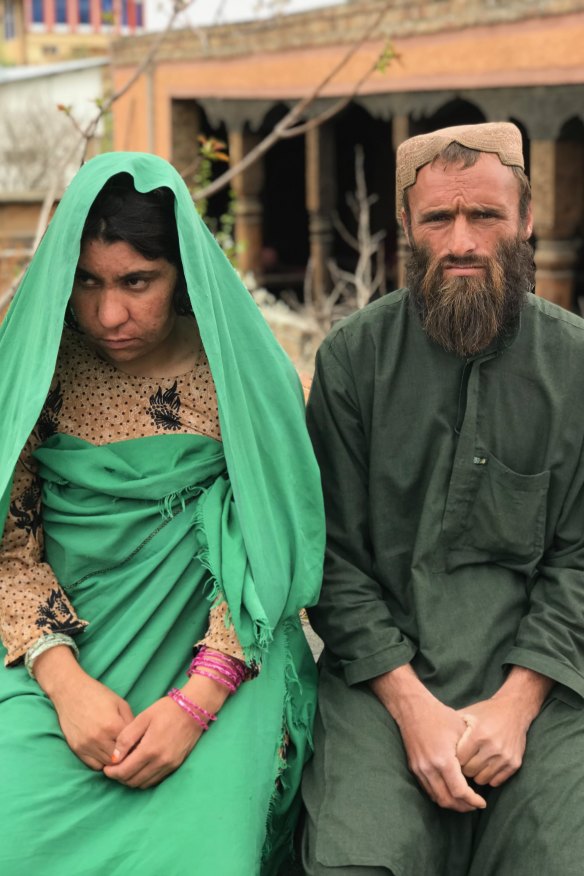
Bibi Dhorko, Ali Jan’s wife, and his brother, Abdul Ahmad, who had to comfort her and her children after news of his death.Credit: Scott Morelli/60 Minutes
Ali Jan’s brother, Abdul Ahmad, was among the villagers Rashid had spoken with. He had comforted Bibi and her children after the news arrived. “His two elder daughters were screaming and running after their grandmother” in a state of bewilderment, pleading to be told their father was alive, Ahmad recalled.
“Ali Jan’s mother was crying day and night for a week,” he said. Ahmad told Rashid that Ali Jan’s death had left Bibi struggling to put food on the table. His family could no longer afford meat or to send the children to school. I asked Rashid for the ages of Ali Jan’s children. When he came to the youngest child, I felt a pang of doubt. Ali Jan’s youngest child was born after his death. I immediately challenged Rashid and he could tell by the tone in my voice that I was sceptical. I could also tell that he was offended.
“Of course I asked about this,” Rashid said.
When Ali Jan died, Bibi was pregnant. After death had come life. Three months after the man fitting the description of Roberts-Smith kicked Ali Jan off a cliff, Bibi gave birth to a baby girl. Ali Jan’s youngest daughter was now five.
Afghanistan, April 2019
An armed guard outside the Kabul hotel patted the cameraman and me down, before opening a reinforced door and herding us into a small guarded antechamber. Once the door behind me was bolted shut, another door was opened and I walked into a large courtyard with terracotta walls lined with tired pot-plants. Ali Jan’s wife, three of their children and her brother-in-law were waiting, along with Rashid.
Bibi Dhorko, 34, was wearing a bright-green shawl that covered her head and most of her face. Her two sons wore traditional Afghan shirts, each a different shade of green, while her daughter was dressed in a bright, colourful tunic. As I spoke, thanking them for making the journey from Oruzgan province, Rashid translated.
The children stared at me, eyes wide, but when I looked back at them, they averted their gazes nervously. I guessed I was one of the few foreigners they had ever met. Bibi avoided eye contact, as was the custom, but I occasionally caught her glimpsing at me with wariness. Her face looked worn, her eyes dark and sad.
Rashid ushered us to a room and when we were seated on an old carpet, he filled our cups with sweet tea. My conversation with Bibi was slow, stilted and solemn, lightened only by the giggles of the children as they played with marbles.
After we moved outside, in front of our camera, I asked Rashid if Bibi could tell me what had happened on the day Ali was meant to return to his home, a three-hour donkey-ride from Darwan. As she spoke, Bibi dabbed at her eyes with her green shawl.
She had finished the morning chores and was preparing lunch to be ready for his return. She had taken her time. No one was in a rush. The kids had their playground of rock crevices and mountain paths to explore. She had supposed Ali would ramble up one of these on his donkey at any moment.
But then an hour passed. And then another. Bibi was at first unconcerned. Ali was a man who avoided trouble, no easy task in southern Afghanistan.
“He didn’t side with anyone and never had a gun,” she told me.
Another hour had passed. It was well into the afternoon when Bibi finally heard someone approaching. It wasn’t Ali, but a young boy from Darwan, sweating and panting, who raced up with the news.
“I started crying, shouting,” Bibi said. “My legs were numb. I couldn’t breathe.”
“I want justice because I have been widowed … my children are now helpless.”
Bibi Dhorko, Ali Jan’s widow, and mother of their seven children
Bibi remembered clearly the last time she saw Ali alive, and the last time he’d seen his children: Guldasta, 8; Sharifa, 7; Sidiqa, 4; Muzdalifa, 3; and their two babies, Mohmmadullah and Nematullah. She remembered him telling her to tend to their plot of land while he was gone. She remembered how Ali then turned to face her and say goodbye.
She also remembered dashing down the rocky path towards Darwan, retracing her husband’s last steps, until she was finally convinced by relatives to turn back. It was too late, they told her.
She remembered seeing blood on the floor of her hut, realising she’d badly cut her feet while running but had not noticed the pain. She was pregnant at the time with her seventh child, a girl who would never meet her father.
Before the interview ended, I asked Bibi if she had a message for Australia.
“I want justice because I have been widowed … my children are now helpless,” she said.
Seven years after Ali Jan was murdered, she was still in mourning, clinging to old memories.
She recalled Ali Jan’s donkey, led by a relative, returning home after his death. The child’s shoes Ali Jan had promised to bring back from his trip to Darwan were strapped to its side.
Sydney, February 2022
The details Chris Masters and I had gathered about the war crime at Darwan were, after weeks of wrangling with editors and lawyers, published in The Age, The Sydney Morning Herald and, a year later, broadcast on 60 Minutes. The revelations and continued reporting prompted Ben Roberts-Smith to make good on his promise to sue us for defamation and, over several weeks in mid-2021, take to the stand to tell his version of events to Federal Court Justice Anthony Besanko.
During his defamation case, Roberts-Smith had forcefully denied that anything sinister had occurred at Darwan. He testified that the villager who we claimed had been kicked off a cliff and executed was, in fact, an insurgent discovered in a cornfield, and shot because he was carrying a radio and posed a risk to soldiers.
Afghan eyewitnesses from Darwan who we had called to testify via video link had disputed Roberts-Smith’s version of events, alleging Ali Jan was detained, beaten, kicked off a precipice and murdered.
But then, Justice Besanko adjourned the trial because of COVID-19 lockdowns. It wasn’t until February 2022 that it resumed and I took up my familiar position in the back row of the court, closest to the door and just metres from Roberts-Smith. Our hope of proving the Darwan execution claim came down to one man: SAS veteran Jason Andrews. Andrews had, prior to Besanko’s lengthy adjournment, made it clear he was too unwell to appear. But in the months that had passed, our hope of getting Andrews to testify had slowly grown.
In early 2022, we got news that he might be open, begrudgingly, to making the trip from Perth to the Federal Court in Sydney.
As I waited for Andrews to be called to the stand on February 28, I once again turned to face Roberts-Smith. We hadn’t said a word to each other, despite sitting only metres apart for days on end. Instead, we exchanged occasional stares and facial gestures.
He now appeared to me as an oversized boy in a suit who, having made his vow of innocence to Kerry Stokes or his father or whomever else he had lied to about what he’d done in Afghanistan, was too arrogant or proud or scared to back down.
On this morning, as we locked eyes, I raised my brows and he did the same, mimicking me. But something had changed. I saw something I had never seen in Roberts-Smith. He now appeared to me as an oversized boy in a suit who, having made his vow of innocence to Kerry Stokes or his father or whomever else he had lied to about what he’d done in Afghanistan, was too arrogant or proud or scared to back down. He’d walked himself to the edge of a cliff. If Andrews’ testimony pushed him over, his lies would be exposed. I almost felt sorry for him.
Then my mind turned to the man actually kicked off a cliff, Ali Jan, and his donkey loaded with flour, wood and shoes for one of his and Bibi’s children, whom I’d met in Kabul three years earlier.
On day one of the trial, the war hero’s barrister, Bruce McClintock SC, had used a very descriptive term in describing the picture our case had painted of Roberts-Smith. McClintock was making the point it was egregiously unjust, but his term was perfect. Ben Roberts-Smith VC, MG, would have to have been an “ostentatious psychopath” to do what we’d alleged.
I was certain of this characterisation because of everything that had preceded Andrews’ impending appearance in court. It wasn’t just the years of journalism. Contrary to the expectations of Roberts-Smith’s legal team, our witnesses – civilian and SAS – had shown up in droves. They had to be forced to court with subpoenas, but once in the stand they had nearly all exceeded our expectations. Roberts-Smith’s barristers Arthur Moses SC and Bruce McClintock had largely been ineffectual, their jocularity and guffawing fading as the days passed.
One of Roberts-Smith’s lawyers, Monica Allen, now seemed nervous when she entered the court, staring at her shoes. Moses still appeared smug, but it was clear that his client’s great hope regarding Jason Andrews would not be realised. Roberts-Smith’s worst nightmare was taking shape: Andrews had arrived in Sydney.
The heart of the journalism that had landed us in court in the first place, and the core of our war crimes defence against Roberts-Smith’s lawsuit, was what happened in Darwan. It was why we had spent the best part of four years battling to get Andrews into court.
But until I saw him enter the courtroom, I wouldn’t breathe out. Even then, it depended on what he said. Would he back up his old friend, the man he once regarded as a brother?
Our barrister Nic Owens would often tell me about the nerves of various witnesses he’d had to prod forward in the box. But that day, prior to court, he disclosed that it was he who was feeling nauseous.
“I’ve never felt so nervous,” Owens said.
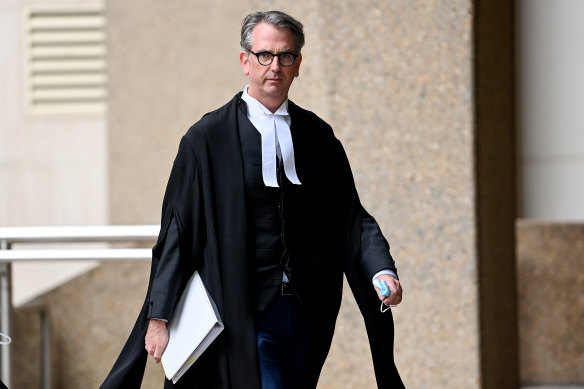
The journalists’ barrister, Nicholas Owens SC.Credit: AAP
If I hadn’t already spent weeks watching Owens on his feet, I might have been worried. But he had performed flawlessly, week in week out. Essentially, though, whether or not Andrews would testify honestly was outside of Owens’ control.
For weeks, I’d sought to gather intelligence. Were Andrews and Roberts-Smith still not speaking? Had anyone got to Andrews? Had they secretly conspired to defeat our case?
The witness door opened and a besuited man with a greying beard strode towards the witness box. Andrews. The building tension was almost too much to bear. Dean Levitan’s face was ghostly pale, his jaw clenched. He looked as nervous as me. I thought briefly of all those years of his life he’d poured into the case.
Owens guided Andrews through his memory of the Darwan mission, leading him slowly to the final compound on the ridge, the place where Roberts-Smith insisted he had arrived with Andrews and a second soldier, Vincent Jelovic*. Jelovic, Andrews and Roberts-Smith were the only SAS soldiers with Ali Jan when he died. We knew Jelovic was a loyal friend of Roberts-Smith who would back Roberts-Smith’s account when it was his turn to testify, for a reason that went beyond mateship. According to our account, Jelovic was also a co-accused. We just needed to prove it.
It wasn’t just me who looked anxious.
The whole courtroom was on edge. Dean Levitan turned around to look at me and nodded. This was the moment of truth. Our case would rise or fall on what happened next.
Andrews took three sips of water and continued, directing his answers to Justice Besanko. According to his recollection, the far compound wasn’t empty. He recalled an Afghan male and a donkey draped in a red rug. The donkey man was detained by Roberts-Smith’s patrol team. A translator was then called for and an interrogation commenced.
I tried to make notes, but I was squeezing my pen so hard my hand cramped. Andrews was already drastically diverting from the account given by Roberts-Smith. Along with the man and the donkey, Andrews recalled at least one other Afghan detainee in the compound that Roberts-Smith had insisted in his testimony was empty.
I stopped writing and focused on Andrews, my heart pounding.
The soldier questioning the donkey man with the help of an interpreter was Roberts-Smith, Andrews said. A short time later, he watched as Jelovic moved “towards a large drop-off”. Andrews sighed audibly. His face looked pained. Gently urged forward by Owens, he pressed on.
Jelovic wasn’t alone. He had guided the handcuffed man to the edge of the cliff and was holding him still, his hand upon his shoulder. Andrews described the Afghan to the court using the military terminology for a detainee in Australian custody: a “person under control”.
“Which person under control are you talking about?” Owens asked quietly.
“The individual that had arrived with the donkey … the person under control had his back towards the large slope,” Andrews answered.
Next, Andrews “noticed Ben Roberts-Smith”.
“He had walked to a position, maybe three or four metres away. And as I was trying to understand what was happening, he turned around, walked forward and kicked the individual in the chest.”
The donkey man was “catapulted backwards” over the cliff edge. As he fell, Andrews “saw the individual’s face strike a large rock … He knocked out a number of his teeth, including his front teeth.”
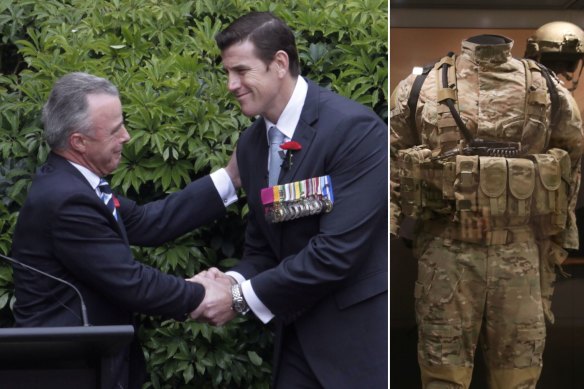
Roberts-Smith with former defence minister Brendan Nelson in 2013 at the Australian War Memorial, and right, part of the Memorial’s Roberts-Smith exhibit, which is now a subject of some debate.Credit: Andrew Meares/Alex Ellinghausen
Andrews described feeling shocked, but still followed Roberts-Smith and Jelovic as they manoeuvred down a track towards the creek bed where the donkey man had landed.
“Might be an obvious question, but why were you in shock?” Owens asked.
“Cause it was something I’ve never encountered before,” Andrews said, his face ashen.
“When you say you’d never seen this before, you’re referring to someone being kicked off a cliff?“
“Absolutely.”
The three soldiers found the donkey man lying in the dry creek bed, dazed and bleeding from the mouth.
“He attempted to sit up and then fell back down again,” recalled Andrews.
“Was he still handcuffed or not?”
“Yes.”
Andrews described Roberts-Smith ordering him and Jelovic to drag the donkey man to the base of a large tree and the pair following the command.
Next, Andrews testified that he walked away from the tree, searching for other members of the SAS. Then he turned back in the direction of the donkey man. The Afghan was now standing, still in handcuffs, so Andrews looked away again. He didn’t want to see what happened, but he knew it had been done when gunshots rang out.
He turned back again, this time to see Jelovic “still in a position with his rifle in his shoulder”. The donkey man was dead.
“And did you observe anything about it that struck you?” Owens asked.
I’d never seen the courtroom so still. Justice Besanko watched Andrews like a hawk as he described noticing that a radio had appeared next to the donkey man’s body. It “was slightly wet”, he recalled. It was then that Andrews realised the radio had been taken from an insurgent Roberts-Smith had earlier waded across a river to kill and then planted on the donkey man.
“[Roberts-Smith] came back into our room and said, ‘This is what the story is …’ ”
Jason Andrews*, witness
But the cover-up wasn’t complete. After they returned to the base, Andrews said that Roberts-Smith met with his small patrol team in their room and invented a false story about killing a Taliban member in a cornfield.
“He came back into our room and said, ‘This is what the story is …’ ,” said Andrews, adding, “Your Honour, it was words to the effect of ‘the story is that we engaged a spotter’.” A spotter was an insurgent with a radio.
As I waited for Arthur Moses to stand and begin the cross-examination, I wondered what else might fall out of Andrews’ testimony. I also slipped off my suit jacket. It was convention to keep it on in court, but I’d been so anxious I’d been sweating.
During the proceedings, Moses had already drawn out information that had helped, or at least hadn’t harmed, our case. He wouldn’t disappoint with Andrews.
Moses pushed Andrews on his relationship with Jelovic, pointing out that he’d been the best man at Jelovic’s wedding.
“And he’s upset with you, is that right?” Moses asked.
“I guess so.”
“Do you know that he’s upset with you because he feels that you have, in effect, accused him of being a murderer?”
“I’d suggest so.”
I watched this line of questioning in bewilderment. It seemed to serve no purpose other than to reinforce the discomfort Andrews so evidently felt in testifying.
The same occurred when Moses accused Andrews of being jealous of Roberts-Smith’s Victoria Cross. Andrews had fought alongside Roberts-Smith at the famous battle of Tizak in 2010, but Andrews had won a Medal for Gallantry, a lesser but still revered award recognising bravery. Roberts-Smith had found fame and fortune, but Andrews had left the army years later, a relative nobody.
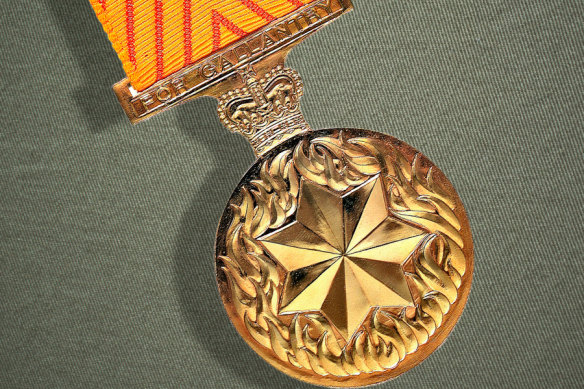
The Medal for Gallantry is awarded for acts of gallantry in action in hazardous circumstances.
So what? I thought. Again, the questioning seemed to fall well short of its intended mark, highlighting only the anguish faced by Andrews in entering the witness box.
“I loved him as a brother,” he said to Moses of Roberts-Smith. “There’s no resentment there.”
“But now you hate him, don’t you?”
“Of course, I don’t hate him.”
“And it’s the case, isn’t it, that you’re jealous of him?”
“Believe me … I’m not jealous of him.”
To highlight the incongruity of Andrews’ claim that Roberts-Smith had later talked openly about the cliff kick after initially trying to cover it up, Moses pushed the Afghan veteran to recall what it was Roberts-Smith had precisely said.
“Is that what he said, ‘I kicked the individual off the cliff’?” Moses asked.
“No, he didn’t say that.”
‘What did he say?’
“I kicked the c--- off the cliff.”
I noticed a Commonwealth lawyer observing proceedings wince as Andrews recalled the words.
Most in the courtroom had now watched my 60 Minutes story about Ali Jan’s alleged execution, care of Moses’ decision to repeatedly replay it on a screen to various witnesses. As a result, they knew the executed donkey man had a name. They knew the “c---” kicked off a cliff had a wife and several children.
Andrews knew it, too. As Moses forced him to watch the program featuring Ali Jan’s family calling for justice, Andrews wept silently.
* Jason Andrews and Vincent Jelovic are not their real names, which have been suppressed by court order. Other names have been altered for security reasons.
In a special deal for subscribers, you can order a copy of Nick McKenzie’s new book, Crossing the Line, from QBD Books for the discounted price of $23.85 with the coupon code TRUTH or by using the barcode at the end of this article in store. This offer is available until July 28. Shipping fees apply for online purchases.
To read more from Good Weekend magazine, visit our page at The Sydney Morning Herald, The Age and Brisbane Times.